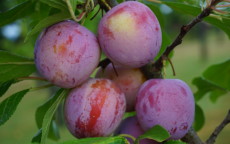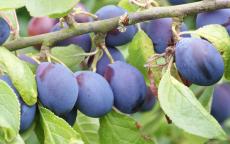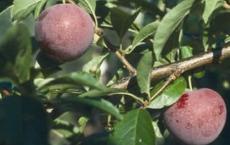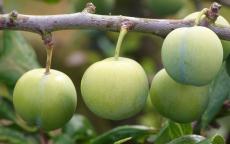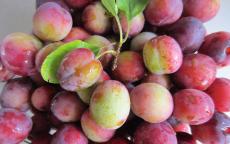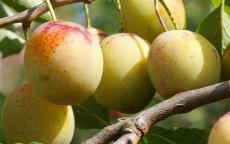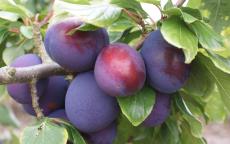- Sub-categories:
- European plums8
- Japanese plums6
Plum trees
If you are new to growing fruit trees, plum trees make an excellent choice. Plum trees are easy to grow - usually easier than apples and pears - and require very little training or pruning. The only horticultural challenge is that plums flower quite early in spring, so locations that are prone to frosts are best avoided (or choose a late-flowering or frost-resistant variety). They thrive in most conditions, but they prefer water-retentive soils, and mulching is therefore particularly important for plum trees - farmyard manure is ideal.
Unlike most apples and pears, many plum varietes are self-fertile or partially self-fertile and do not need a pollination partner. For plum varieties that are not self-fertile, another plum tree of a different variety flowering at the same time is usually all that is necessary to ensure good pollination and heavy crops - there are few of the pollination incompatibilities found with apples, pears and cherries.
Plums are also more nutrient-rich than apples or pears, and comparable to some other "superfoods" such as blueberries. Although plum trees do suffer from a range of diseases, they seem to catch them less often than other fruit varieties. Most important of all, the flavour of ripe home-grown plums is vastly superior to shop-bought fruit. Indeed in our opinion freshly-picked dessert plums can offer the most exquisite sweet flavours of any fruit available from the temperate garden.
We offer both 'European' plum trees from the species Prunus domestica - and Japanese plums from the species Prunus salicina. The two species do not cross-pollinate - in part because Japanese plums tend to bloom much ealier than European ones. Japanese plums also tend to ripen a bit earlier, from June to August, whereas European varieties tend to ripen from July to September.
AU Rosa
AU Rosa is a heavy-cropping and self-fertile red plum, related to the popular Santa Rosa but with better disease resistance.- Picking season: Mid
- Gardening skill: Average
- Self-fertility: Self-fertile
- Pollination group: 1
Bluebyrd
A late-season disease-resistant European plum with a dark blue skin and a sweet flavor.- Picking season: Late
- Gardening skill: Average
- Self-fertility: Not self-fertile
- Pollination group: 3
Castleton
A reliable early-season dual-purpose plum.- Picking season: Early
- Gardening skill: Beginner
- Self-fertility: Partially self-fertile
- Pollination group: 3
Count Althan's Gage
Count Althann's Gage, also known as Reine Claude Conducta, a true gage but with a richer and more plum-like flavor than other gages.- Picking season: Mid
- Gardening skill: Average
- Self-fertility: Not self-fertile
- Pollination group: 4
European Damson
A European-style Damson plum, with a traditional rich astringent flavor.- Picking season: Mid
- Gardening skill: Beginner
- Self-fertility: Not self-fertile
- Pollination group: 3
Geneva MirabelleTM
An American mirabelle, similar in style to the traditional French mirabelles.$41.95buy- Picking season: Mid
- Gardening skill: Average
- Self-fertility: Not self-fertile
- Pollination group: 3
Methley
Methley is an early-season Japanese plum. It is reliably self-fertile, and crops heavily from a young age.- Picking season: Early
- Gardening skill: Average
- Self-fertility: Self-fertile
- Pollination group: 1
Old Green Gage
The definitive gage - Old Green Gage is arguably the best-flavored of any plum variety.- Picking season: Late
- Gardening skill: Experienced
- Self-fertility: Not self-fertile
- Pollination group: 3
Opal
Opal is an early European plum variety with a good flavor, self-fertile and very easy to grow.- Picking season: Early
- Gardening skill: Beginner
- Self-fertility: Self-fertile
- Pollination group: 3
Oullins Gage
The golden yellow plums of Oullins Gage have an excellent rich sweet flavor.- Picking season: Mid
- Gardening skill: Beginner
- Self-fertility: Self-fertile
- Pollination group: 4
President
A late-season English dual-purpose plum, notable for heavy crops of large plums.- Picking season: Late
- Gardening skill: Beginner
- Self-fertility: Not self-fertile
- Pollination group: 3
Rosy GageTM
Rosy Gage is a sweet-flavored European-style plum ripening in late August.$39.95buy- Picking season: Mid
- Gardening skill: Average
- Self-fertility: Not self-fertile
- Pollination group: 3
Santa Rosa
Santa Rosa is the definitive Japanese plum, with dark red skin and a sweet rich flavor.$41.95buy- Picking season: Mid
- Gardening skill: Average
- Self-fertility: Self-fertile
- Pollination group: 1
Toka
Toka is a cold-hardy Japanese-style plum, also known as Bubblegum on account of its sweet fruity flavor.- Picking season: Late
- Gardening skill: Average
- Self-fertility: Not self-fertile
- Pollination group: 2
Victory
A very late ripening prune-style plum, and one of the largest-fruited of all plums.- Picking season: Late
- Gardening skill: Average
- Self-fertility: Not self-fertile
- Pollination group: 4

